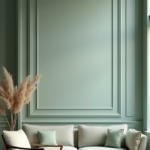If you’re searching for a soft, subtle, and sophisticated neutral paint color, look no further than Benjamin Moore Wind’s Breath. This versatile hue is increasingly becoming a favorite among interior designers and homeowners alike for its warm undertones, earthy elegance, and ability to adapt beautifully in any space.
In this complete color review, we’ll break down everything you need to know about Benjamin Moore Wind’s Breath, including undertones, color codes, best room applications, coordinating colors, and expert design tips.
🎨 What Color Is Benjamin Moore Wind’s Breath?
Wind’s Breath (OC-24) by Benjamin Moore is a light warm greige—a blend of beige and gray—with soft, muted undertones. It sits comfortably between a warm off-white and a neutral beige, offering a timeless and calming aesthetic.
Unlike stark whites or cool grays, Wind’s Breath brings warmth and comfort to interiors without overwhelming them with color. It’s ideal for those seeking a refined and airy neutral that still has character.
🧾 Color Codes for Benjamin Moore Wind’s Breath
Here are the accurate color codes for Wind’s Breath (OC-24):
- HEX Code: #EDE7DD
- RGB Code: R: 237, G: 231, B: 221
- LRV (Light Reflectance Value): 69.59
👉 LRV of 69.59 means this color reflects a good amount of light, making it perfect for brightening up darker rooms while still offering depth and contrast.
🔎 Wind’s Breath Undertones: What to Expect
The undertones of Benjamin Moore Wind’s Breath are subtle but important:
- Beige with soft taupe hints
- Very mild pink-violet undertones in certain lighting
- Warm and cozy, not stark or cold
💡 Pro Tip: In north-facing rooms, it can appear slightly cooler. In sunlit south-facing rooms, the warm undertones are more pronounced, making it feel creamier.
🛋️ Best Rooms to Use Wind’s Breath
Thanks to its adaptability, Wind’s Breath suits a wide range of rooms and design styles:
1. Living Rooms
Perfect for creating a calm, cohesive, and welcoming atmosphere. Pairs well with wood floors, linen furniture, and soft accent hues.
2. Bedrooms
Its muted softness makes it ideal for bedrooms, promoting relaxation and serenity.
3. Kitchens
Works wonderfully on walls or cabinets, especially paired with brushed nickel or gold hardware.
4. Bathrooms
Provides a spa-like ambiance with just enough warmth to avoid a clinical look.
5. Hallways & Entryways
Brightens narrow spaces while keeping the palette grounded and inviting.
🎯 Complementary & Coordinating Colors
Looking to build a full palette around Benjamin Moore Wind’s Breath? Here are some beautiful pairings:
| Color Type | Benjamin Moore Color | Description |
|---|---|---|
| Trim/Accent | Chantilly Lace (OC-65) | Crisp, bright white for contrast |
| Warm Neutral | Edgecomb Gray (HC-173) | Slightly deeper greige |
| Cool Accent | Pale Oak (OC-20) | Soft cool neutral |
| Deep Contrast | Chelsea Gray (HC-168) | Moody and dramatic for contrast |
| Earthy Tone | Grant Beige (HC-83) | Rich beige for a warm aesthetic |
🆚 Wind’s Breath vs Similar Colors
Let’s compare Wind’s Breath with a few other popular Benjamin Moore neutrals:
| Color | Undertone | LRV | Comparison |
|---|---|---|---|
| Wind’s Breath (OC-24) | Beige/taupe | 69.59 | Warm, soft, airy |
| Pale Oak (OC-20) | Greige/violet | 69.89 | Cooler and slightly more gray |
| Edgecomb Gray (HC-173) | Beige/green | 63.88 | Darker and more saturated |
| Classic Gray (OC-23) | Warm gray | 74.78 | Brighter and lighter |
🔍 Summary: Wind’s Breath is warmer than Pale Oak and lighter than Edgecomb Gray, making it a balanced choice for those who want a neutral with depth.
🖼️ Styling Tips for Wind’s Breath Walls
Here’s how to make Benjamin Moore Wind’s Breath shine in your space:
- Use natural materials like jute rugs, wood, and rattan for an earthy, organic vibe.
- Pair with black window frames or matte black decor for a modern contrast.
- Combine with muted greens, soft blues, or terracotta for a layered palette.
- Use textured fabrics like linen, velvet, and boucle to add dimension.
✅ Pros and Cons of Benjamin Moore Wind’s Breath
✔️ Pros:
- Warm, inviting tone that isn’t too yellow
- High LRV: great for lightening up small or dark spaces
- Works across various design styles (modern, traditional, farmhouse, etc.)
- Pairs well with a wide range of colors
❌ Cons:
- Can appear too warm or slightly pink in some lighting
- Might not contrast well with cool gray finishes
🛒 Where to Buy & How to Sample Wind’s Breath
You can purchase Benjamin Moore Wind’s Breath (OC-24) at any authorized Benjamin Moore retailer, or order a peel-and-stick sample from companies like Samplize to see it in your space before committing.
🔨 How to Test Paint Colors the Right Way:
- Paint a large sample swatch on multiple walls in your space.
- Observe it during different times of day.
- Pair it with your furniture and decor to see how it reacts.
📋 Final Verdict: Is Wind’s Breath Right for You?
Benjamin Moore Wind’s Breath is a fantastic all-around neutral. Whether you’re revamping a living room, designing a cozy bedroom retreat, or updating your entire home’s palette, Wind’s Breath offers timeless appeal, gentle warmth, and wide compatibility with almost any design style.
If you’re looking for a neutral that’s light but not stark, warm but not too yellow, and refined without being boring, Wind’s Breath is absolutely worth a try.
🙋♀️ FAQs About Benjamin Moore Wind’s Breath
Is Wind’s Breath a warm or cool color?
It is a warm neutral with beige undertones, but it can shift slightly depending on lighting.
What is the LRV of Wind’s Breath?
The Light Reflectance Value is 69.59, meaning it reflects a good amount of light, ideal for brightening spaces.
What trim color works best with Wind’s Breath?
Try Chantilly Lace (OC-65) or Simply White (OC-117) for a crisp, modern trim.
Is Wind’s Breath good for exteriors?
Yes, it works well for exteriors, especially when paired with darker accents like black shutters or bronze fixtures.
Does Wind’s Breath work with gray or greige furniture?
Absolutely. Its subtle warmth complements cool grays and soft greiges beautifully.
📌 Final Thoughts
Benjamin Moore Wind’s Breath is more than just a paint color—it’s a mood. Neutral, nuanced, and naturally elegant, it’s the kind of shade that can transform your home with a serene, sophisticated touch. Whether you’re after a clean backdrop or an inviting warmth, this paint is a must-sample.



